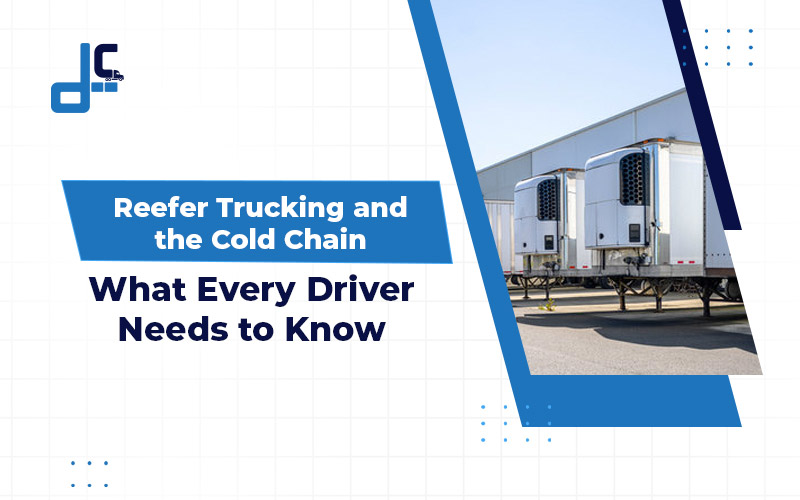The food and beverage industry helps immensely in powering the US economy and amounts to about 5% of the GDP. There are some specialized trucks that transport these temperature sensitive goods called reefer trucks. Reefer trucking involves attaching a refrigerated trailer to a semi-truck to ensure the safe delivery of goods. This mode of transportation is vital for businesses that need to supply temperature-controlled goods in a timely and safe manner.
In this blog, we will understand what a reefer truck is and what every driver needs to know about it.
What is a Reefer Truck?
A reefer truck is usually a specialized vehicle that has a refrigerated trailer attached to a semi-truck. The attached refrigerated trailer is called the reefer which aids in transporting the perishable goods at controlled temperatures. These perishable goods can be meat, dairy, fruits or any pharmaceuticals that sustain only at a particular temperature. The ability of reefer trucks to maintain a consistent temperature helps in maintaining the quality and safety of such goods.
How is Reefer Trucking and Cold Chain Related?
As you now know what is reefer trucking, it’s time to understand what is a cold chain? A cold chain is a type of supply chain that ensures the safe delivery of perishable and temperature sensitive goods. From cold packaging to goods being transported in reefers till their final delivery safely, every aspect is maintained in the cold chain. Reefer trucking is an essential aspect of the cold supply chain as it ensures that goods are not spoiled or deteriorated and are delivered safely.
Why is Reefer Trucking Needed?
Reefer trucking is needed by those businesses who require to transport their temperature sensitive goods. These goods are often prone to damage if not maintained at a particular temperature. Reefers thus ensure that these goods are maintained at their set temperature and arrive at the destination in the proper condition they were at the time of loading.
How Does a Reefer Work?
The reefer is attached at the back of the truck and is connected to the cargo area via tubes. It is powered by the truck’s engine and by a specialized type of fuel called reefer fuel. It then circulates the refrigerant through a loop system where it absorbs heat from inside and releases it outside. This process keeps the interior cool and thus maintains temperature for keeping the quality of the perishable goods intact.
Essential Things to Consider in Reefer Trucking
For drivers that work in reefer trucking or are planning to start driving a reefer truck, it is essential that they understand and are aware of some of the key considerations regarding reefer trucking.
Monitoring and Documenting Temperature in the Reefer
Reefer trucks do come with advanced temperature control systems but as a driver it is your responsibility to ensure temperatures are monitored. One simple mistake can lead to deteriorating your goods. So, make sure you are monitoring and documenting the temperature in the reefer unit throughout your journey. The documentation is essential for quality control and to see if you are in accordance with the industry regulations.
Stuffing and Placement of Cargo
As a reefer truck driver, you need to ensure that the cargo does not get stuffed beyond the end of the T-floor and above the red load line. The goods to be transported should pe pre-cooled before being packed into the reefer. You should also make sure that there is no overloading and proper ventilation is set at the correct level. While loading your reefer, make sure there is proper air circulation and consistent temperature is maintained.
Pre-Trip Inspection (PTI)
The Pre-Trip Inspection (PTI) is an inspection that you need to perform as a responsible driver to ensure reefers run smoothly. Through the PTI, you inspect your reefers based on some guidelines. These can include checking fasteners, bolts, hatches and doors and replacing them if needed. You need to check the filter drier for deterioration and replace it if needed. Additionally, you need to ensure the water coolers are not jammed and there is no cable damage.
Loading and Planning Routes
To maintain the cold supply chain, you need to ensure safe loading and careful truck route planning. You should plan routes in advance to avoid any delays and ensure timely and safe deliveries. Following proper loading practices such as ensuring airflow and pre-cooling helps maintain temperature in your reefer unit. Moreover, route planning that helps avoiding sudden stops can help you maintain a safe journey.
Understanding Industry Regulations
As a driver in reefer trucking, you must be aware about all the industry regulations relating to transportation of perishable goods. These regulations include maintaining temperature, ensuring food safety, etc. Moreover, there are some pricing regulations that you need to abide by. They may vary depending on factors like distance covered, temperature requirements, seasonality, and type of goods.
Let’s Wrap Up
So now you must be aware of reefer trucking and how essential it is in a cold chain. By being aware of key things to consider in reefer trucking, you can ensure that goods are not spoilt in between the journey. It will also prepare to handle any challenges that may arise during the transit time.
If you are someone who owns a reefer truck and face difficulties finding loads, we at Dispatch Circle are here to help! With our team of dedicated reefer truck dispatchers, we provide loads whenever you are in need. Our focus is to get you the best deals. Contact us today to start your journey.
